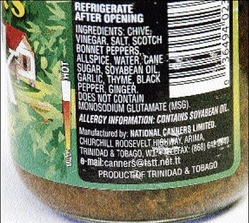Teach children to read food labels
Published: Wednesday | November 25, 2009

'Parent the right way- Read with Your Child Every Day' is the theme chosen for Parent Month November 2009. The Minister of Education, Honourable Andrew Holness, reminded us in his Parent Month message, of the adage 'today a reader, tomorrow a leader', and implored Jamaican families to make a concerted effort to read with their children and to work hard to unlock their potential.
One very interactive reading exercise that can be carried out with parent and child is the reading of labels. This can be done at the supermarket, in the kitchen and even when the child makes purchases at the tuck shop with peers. Parents should first understand how to read the label, then find creative ways to make it come alive to the child, starting with one of their favourite food packages.
1. Picture panel
The picture panel is designed to attract the attention of the buyer and has no real bearing on content. Usually, the content's colour and size are not similar to items in the picture panel. Do not rely only on the picture to make decisions about value of the contents.
Activity
Get children to compare various picture panels to the actual package content.
2. Ingredient listing
By law, package contents should be listed on the label under ingredients. Children should be warned that it is unsafe to purchase food items without this listing. The name and address of the manufacturer should also be clearly visible on the label. Items are listed starting with largest content item. Some ingredients, such as sugar, are sometimes called glucose, fructose, and so on. Other ingredients, such as sodium, can be written as salt, monosodium glutamate, and so on.
Activity
Identify items on the labels which are the largest and smallest.
Identify different types of sugars on food labels.
Identify different types of sodium names on food labels.
3. Nutrition label
This label or panel gives information on the major food nutrients, that is, carbohydrates, protein and fat in addition to cholesterol, sodium and fibre according to serving size. The serving size is designated by the manufacturers and can be one cup, half cup, four crackers, one slice, and so on. The nutrition label also compares the amount per serving as a percentage of a daily diet of 2,000 or 2,500 calories. This is a guide, as your individual daily caloric requirement may be different.
Activity
Ask children to locate the nutrition label.
Ask children to identify the serving size for each label.
Ask children to identify the amount of nutrients per serving.
This is a great opportunity for reading, education and quality time.
Rosalee M. Brown is a registered dietitian/nutritionist who operates Integrated Nutrition and Health Services; email: yourhealth@gleanerjm.com.

The label on this bottle of jerk season clearly states that it is a product of Trinidad and Tobago. Why does Jamaica need to import jerk seasoning from anyone?
- Rudolph Brown/Photographer


